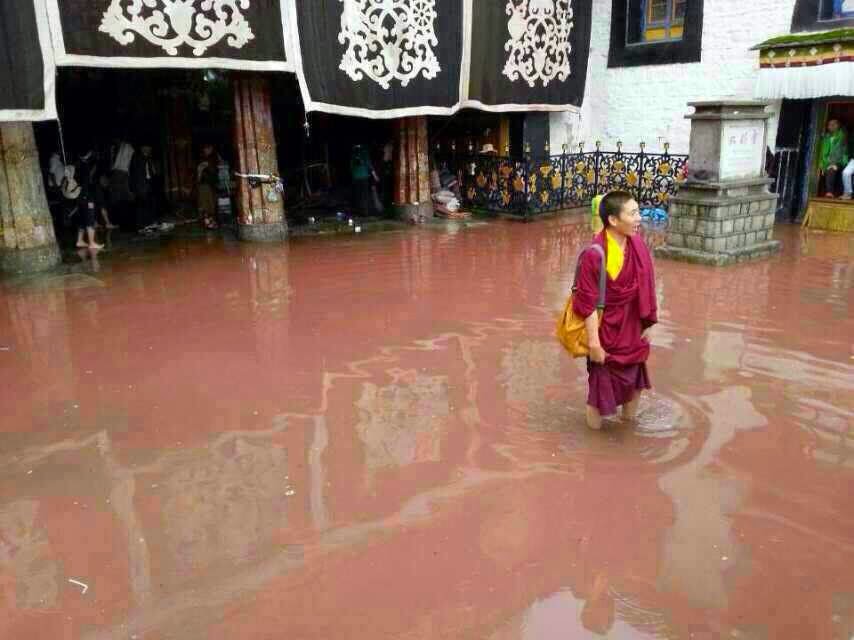
High Peaks Pure Earth has translated a blogpost by Woeser written in July 2014 for the Tibetan service of Radio Free Asia and published on her blog on July 31, 2014.
In this post, Woeser returns to the topic of the changing city of Lhasa. In 2012, Woeser wrote about the increasing commercialisation of the old town, which was a precursor to the 2013 article, “Our Lhasa is on the Verge of Destruction! Please, Save Lhasa!”, that prompted international outcry.

Photos above taken from Weibo, WeChat and Facebook
“People’s Project” or “Face-work”?
By Woeser
Lhasa’s summers are rainy, moderate during the day, but heavy at night. Even though summers no longer do justice to the saying that people once used to refer to Lhasa’s summers, “8 spokes of the wheel in the sky, 8 lotus petals on the ground”, but the air is still clear and the vegetation full of vitality.
It is not just me, not many Lhasa people remember days of pouring rain. This, of course, does not mean that there have not been any floods in history. According to the natural disaster records kept inside Potala Palace, between 1803 and 1958 in today’s Tibet Autonomous Region, 86 floods occurred because of “heavy and continuous rainfall, day and night” that led to the overflowing of river beds. The Shigatse and Lhokha areas were most severely affected, with Lhasa coming second.
As written in the book “Seven Years in Tibet”, the famous Heinrich Harrer and his companion Peter Aufschnaiter came to Tibet in 1944 to work for the government of Tibet. They drew maps of the city, participated in urban construction, planned the drainage system, and were involved in the designing and building of a new dike along Lhasa river. Afterwards, Lhasa was never again affected by flood disasters.
On July 1, 2013, the “Lhasa Old Town Protection Project” was completed, it was one of China’s most important projects, it is said that they invested 1.5 billion Yuan. “Its main focus lies on improving the old town’s outdated infrastructure and resolving the existing fire hazards… it includes the installation of underground pipelines, electricity, the refurbishment of the drainage system, the reinforcement of fire control, as well as the protection of the old town’s special scenery, including the development of energy-efficient buildings and general heritage protection work.” Simultaneously, they also carried out the “comprehensive Lhasa River (city section) renovation project”, which included the building of six watergates for the sum of 3.532 billion Yuan. It was propagated as a measure to perfect the city’s flood control system.
A year of heavy rainstorms later, however, revealed serious problems, to the extent that Lhasa people wondered: Was this the government’s “people’s project” or was it merely “face-work”? A person from Lhasa said: “I have heard of Lhasa river inundating, but I have never heard of water flooding the temples”. From photos we can see how water reached the entrance of Lhasa’s most sacred temple – the Jokhang temple in the heart of old Lhasa – even obstructing the elderly men and women who came on pilgrimage. The new “old town of Lhasa” that had just been renovated into a sumptuous-looking area, was flooded so that cars’ wheels were half covered by water. A Lhasa resident said: “This is a drainage problem that only emerged after the restoration.”
A netizen lamented on Weibo: “For hundreds of years, Lhasa’s old town was just fine; but thanks to the local government’s redevelopment project, yesterday’s rainstorm turned into something like this! It just proves how amazing the drainage system is, it is unbelievable! I hope the respective government departments will take this seriously. I hope they will investigate this. Out of each Yuan in Tibet, 9 mao (cents) come from the Central Government. This is how they wasted this money. Horrible.”
Another netizen revealed: “On the 11th in the afternoon, Lhasa was hit by heavy rainstorm, my colleagues at work came out with photos of Lhasa’s streets being totally flooded, most severely on Chumig Street, Kongpo Street and New Shol Street. The Lhasa City government management staff need to respond to this. The reason why the situation is especially bad on Chumig Street is because the water pipes there are old, and the diameter of the drainage holes are too small.”
Tibetans outside Tibet were worried when seeing the photos of Lhasa under water: “Lhasa is the spiritual centre for millions of people. It is not too late yet for the Mayor to take action and repair the drainage system. I know that Tibet is under the rule of China, but it is our homeland, and yet, one day it may be too late and it will never be our home again.”
July 2014











Follow Us!